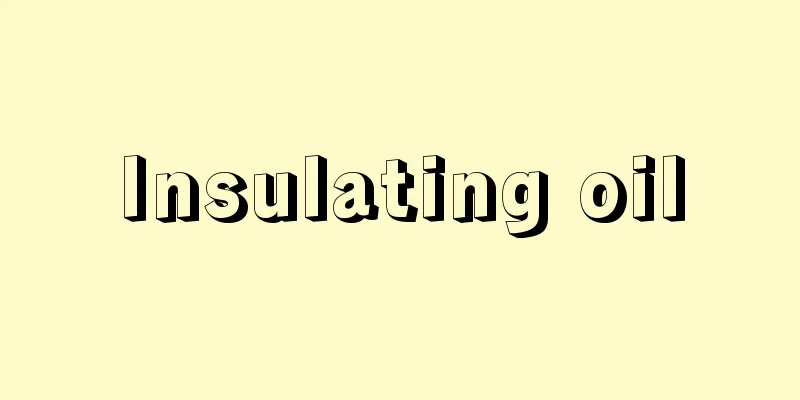Insulating oil

|
Oil used for insulation and cooling of oil-filled electrical equipment such as oil-filled transformers, capacitors, circuit breakers, and cables. The insulation method of immersing paper-insulated coils or conductors in oil to increase dielectric strength has been widely used for a long time in transformers, power cables, etc. The required characteristics vary slightly depending on the application, but they are required to have few impurities, excellent electrical insulation, chemical stability, and resistance to oxidative deterioration. They are broadly divided into mineral oil, which is obtained by fractional distillation and refining petroleum-based crude oil, and synthetic insulating oil. Mineral oil has been used from the beginning of the 20th century to the present day, and its main components are naphthenic, paraffinic, and aromatic hydrocarbons. Mineral oil is an excellent insulating oil, but when heated in air, it is easily oxidized and deteriorates. It also has drawbacks such as a low flash point and high flammability. To overcome these drawbacks, synthetic insulating oils have been put into practical use, with alkylbenzene and polybutene being used in cables and capacitors, and polychlorinated biphenyls (PCBs) being used in transformers and capacitors. Of these, PCBs, which have been widely used as a non-flammable oil with excellent thermal stability, were discontinued in Japan in 1972 (Showa 47) due to pollution problems. Instead of this, alkylnaphthalenes and alkyldiphenylethanes are now used in capacitors, and silicone oils are used in transformers. Furthermore, vegetable oils such as rapeseed oil and coconut oil have been attracting attention as environmentally friendly insulating oils since around 2000 (Heisei 12). [Shin Kubota and Yoshimichi Oki] [Reference item] |Source: Shogakukan Encyclopedia Nipponica About Encyclopedia Nipponica Information | Legend |
|
油入(あぶらいり)変圧器、コンデンサー、遮断器、ケーブルなどの油入電気機器の絶縁および冷却に用いる油。紙で絶縁したコイルあるいは導体を油に浸して絶縁耐力を高める絶縁方式は、古くから変圧器、電力ケーブルなどに広く用いられている。用途によって要求特性は多少異なるが、不純物が少なく、電気絶縁性が優れ、化学的に安定で酸化劣化しにくいことなどが要求される。石油系原油を分留精製して得られる鉱油と、合成絶縁油とに大別される。鉱油は20世紀の初めから今日に至るまで用いられているもので、ナフテン系、パラフィン系、芳香族系の炭化水素が主成分となっている。 鉱油は優れた絶縁油であるが、空気中で加熱されると、酸化劣化しやすい。また引火点が低く、燃えやすいなどの欠点がある。これら欠点を改良する絶縁油として、化学的に合成した合成油系絶縁油が実用化されるようになり、アルキルベンゼンやポリブテンなどがケーブルやコンデンサーなどに、ポリ塩化ビフェニル(PCB)が変圧器やコンデンサーなどに使用されるようになった。このうち、熱安定性に優れた不燃性油として広く用いられてきたPCBは、日本では1972年(昭和47)に公害問題から製造が中止された。これにかわる絶縁油としてアルキルナフタレンやアルキルジフェニルエタンがコンデンサーに、シリコーン油が変圧器に用いられるようになっている。さらに、2000年(平成12)ごろから菜種油ややし油といった植物油が、環境に優しい絶縁油として注目されている。 [久保田慎・大木義路] [参照項目] |出典 小学館 日本大百科全書(ニッポニカ)日本大百科全書(ニッポニカ)について 情報 | 凡例 |
<<: Sekka (English spelling) fan-tailed warbler
Recommend
Anadromous migration
…They enter rivers in late spring, when the water...
Atomic Energy Basic Law
The Atomic Energy Basic Act is treated as the law ...
Evaporation meter - Evaporation meter
This is an instrument for measuring the amount of...
Chin hair - Gakumo
…They have a pair of eyes on the back of their he...
Ring current effect
...This is because the hydrogen in the ring exper...
Connotation
...The distinctive feature of natural language is...
Industrial structure - Sangyōkōzō (English spelling) industrial structure
It refers to the relationship between industries ...
Burton, H.
…Adventure novels also developed through J. Masef...
Total eclipse - total eclipse
A solar eclipse is a phenomenon in which the main ...
Uranium manufacturing and processing process - Uranium manufacturing and processing
...The life cycle of uranium (U) used to utilize ...
Conical projection - Conical projection
A general term for map projections in which meridi...
Kokichi Tsuburaya
A long-distance runner. Born in Fukushima Prefectu...
McBride
1904‐88 Irish lawyer and politician. Born to John ...
Tikopia Island (English spelling)
An island in the southwest Pacific, east of the So...
Library of Alexandria
One of the great libraries of classical antiquity,...









